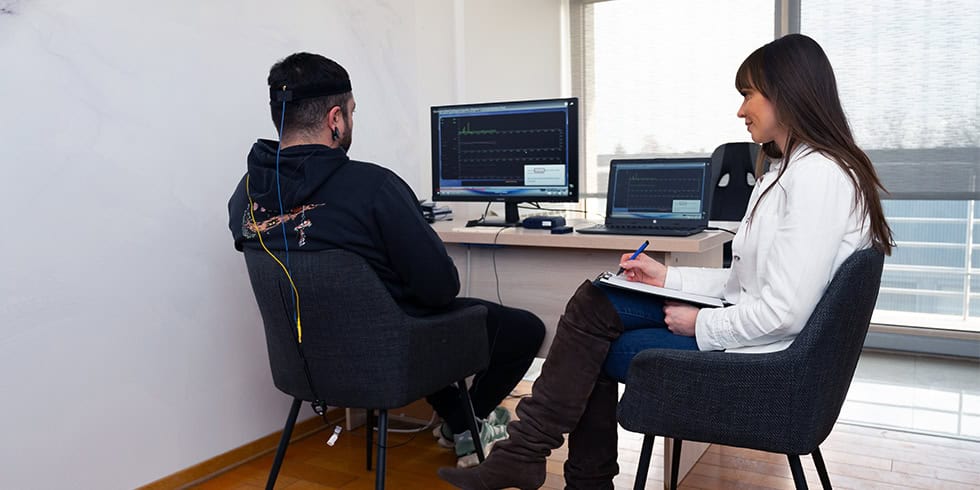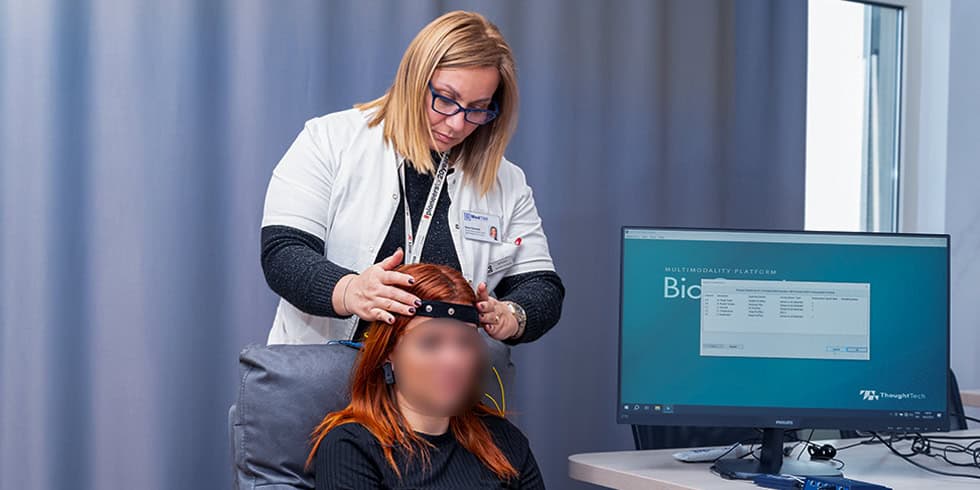Possibility of cost reimbursement through health insurance
Neurofeedback therapy is a modern method that enables individuals to enhance brain function, improve cognitive abilities, and achieve emotional balance through technology. The therapy is based on monitoring the brain’s electrical activity and providing real-time feedback to patients in order to regulate brain activity.
The goal of the therapy is not only to reduce symptoms but also to achieve lasting improvement in brain function through the process of self-regulation. This method helps the brain recognise and modify its own activity patterns, allowing it to respond more effectively to stress and other external influences.

In addition to treating specific conditions, neurofeedback therapy is increasingly popular among healthy individuals who wish to enhance their mental strength, concentration, and resilience to stress. Athletes, executives, and public figures use this method to improve focus and boost performance in everyday life.
Neurofeedback, also known as EEG biofeedback, is a technique that uses sensors placed on the scalp to monitor brain activity and provide real-time feedback. Using an electroencephalogram (EEG), the patient gains insight into their own brainwaves and learns how to consciously change them in order to achieve an optimal mental state.
This method enables the brain to recognise its own activity patterns and adjust them through a learning process. Feedback is most often presented visually, through video games or graphic displays on a screen. When the brain is in the desired state, the patient receives a reward—such as the continuation of the video game or a change in the image on the screen—which encourages correct activity.
Modern life brings numerous challenges, from everyday stress and anxiety to problems with concentration and sleep. Neurofeedback therapy offers an effective and natural way for individuals to improve their mental and cognitive functions, achieve emotional stability, and develop the ability to self-regulate. The goal of the therapy is not only temporary relief of symptoms but also lasting improvement in brain function through a process of adaptation and learning.
Through neurofeedback training, patients become aware of their brain activity patterns and learn how to consciously modify them in order to reach an optimal state of mind. This leads to improvements in daily functioning—better concentration, easier stress management, and greater emotional resilience. The therapy is often used as part of a comprehensive approach to treating various conditions, but also as a tool for enhancing performance in healthy individuals.
Neurofeedback therapy begins with an initial assessment aimed at identifying the patient’s specific needs and creating an individualised treatment plan. The process is tailored to each person, depending on their symptoms, goals, and current brain state.
The first step involves brain mapping using quantitative EEG (qEEG). During this process, electrical activity is measured in different regions of the brain to identify areas that are out of balance. This brain map provides the therapist with a detailed insight into the patient’s brainwave patterns and enables the development of a personalised treatment plan.
For example, individuals with anxiety often show excessive beta wave activity, while those suffering from insomnia may have a deficiency in alpha waves needed for relaxation. Based on this data, targeted brain areas for treatment during the sessions are determined.
The duration of therapy depends on the condition being treated and the individual progress of the patient. On average, between 20 and 40 sessions are required to achieve the desired result. Sessions are typically conducted 2–3 times a week.
Initial results may be noticeable after 5–10 sessions, but for longer-lasting changes, completing the full cycle is recommended. For more complex conditions, such as neurological damage, extended treatment with additional cycles may be necessary.
Neurofeedback therapy is supported by numerous studies that confirm its effectiveness in treating various psychological and neurological conditions. Unlike conventional therapies, which often rely on medication, neurofeedback offers a natural way to improve brain function through training and learning. The effects of the therapy are long-lasting, as the brain “learns” to maintain optimal activity patterns even after the treatment ends.

Biofeedback is a technique that enables individuals to learn how to control various physiological functions of their body using real-time feedback. Unlike neurofeedback, which focuses solely on brain waves, biofeedback encompasses a wide range of bodily functions, such as breathing, heart rate, muscle activity, body temperature, and skin electrical activity.
This method helps patients become aware of their bodily reactions and teaches them how to voluntarily modify them in order to improve health and increase their sense of control over stress and tension. The goal of biofeedback is self-regulation of the body and achieving a balance between physiological and mental functions.
During the treatment, the patient is connected to sensors that measure bodily functions. Feedback is provided via a computer screen or emitted through sound signals. For example, if the patient is training their breathing, they may see a graphical display of their breathing rhythm on the screen and learn how to align it with an optimal pattern.
This process helps patients recognize when they are under stress and then apply the techniques they have learned to reduce stress responses and return the body to a state of relaxation.
The cost of neurofeedback and biofeedback therapy depends on the individual needs of the patient, the number of recommended sessions, and the duration of the therapy. Typically, a cycle of 20 sessions is recommended, with a frequency of 2–3 treatments per week. Prices may vary depending on the clinic’s facilities, the therapist’s experience, and any additional services offered.
For accurate information on prices and available treatment packages, please contact us.
Neurofeedback and biofeedback therapies are designed for a wide range of users, but they are particularly beneficial for individuals dealing with various psychological disorders and those undergoing addiction recovery. These therapies offer a safe, non-invasive, and effective way to gain control over one’s emotions and bodily reactions, which can be a crucial factor in the recovery process.
Neurofidbek i biofidbek terapije namenjene su širokom spektru korisnika, ali su posebno korisne za osobe koje se suočavaju sa različitim psihološkim poremećajima i one koje su u procesu lečenja od bolesti zavisnosti. Ove terapije nude siguran, neinvazivan i efikasan način da se uspostavi kontrola nad sopstvenim emocijama i telesnim reakcijama, što može biti ključni faktor u procesu oporavka.
Individuals Recovering from Addiction
Neurofeedback and biofeedback have proven to be extremely helpful in working with individuals recovering from addiction to alcohol, opioids, stimulants, and medications. The addiction process often leads to disruptions in brain activity, making it difficult to return to a stable state even after stopping substance use. These therapies assist in:
Integrated Therapy for Greater Success

Combining neurofeedback and biofeedback therapies provides a comprehensive approach that simultaneously targets brain function and the body’s physiological responses. This integrated method is particularly effective for individuals with complex conditions such as chronic stress, psychological disorders, and addiction.
The aim of this approach is to establish balance between mental and physical health, leading to lasting changes in how the brain and body respond to external stimuli. While neurofeedback helps regulate brain activity, biofeedback enables greater control over bodily functions such as breathing, heart rate, and stress responses.
When is a combined therapy recommended?
Benefits of the integrated approach
Neurofeedback and biofeedback therapies are completely safe, non-invasive, and well-researched methods used worldwide in medical and therapeutic protocols. Unlike pharmacological treatments, these therapies have no side effects and are based on the brain and body’s natural ability to adapt and learn through feedback.
These methods have a long history of research, particularly in the fields of neurology and applied psychophysiology. Numerous clinical trials confirm their effectiveness in treating attention disorders (ADHD), anxiety, depression, migraines, and sleep disorders.

If you believe that neurofeedback or biofeedback therapy could benefit you or your child, don’t hesitate to contact our team of specialists. The initial assessment includes a consultation with a therapist and brain activity mapping, after which a personalised treatment plan is created.
Take the first step towards better mental health today!